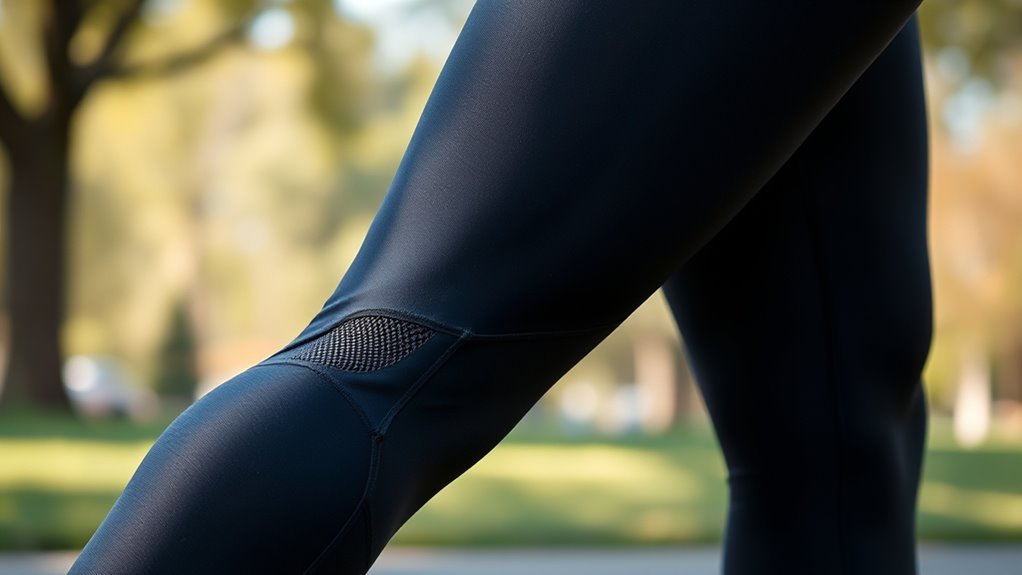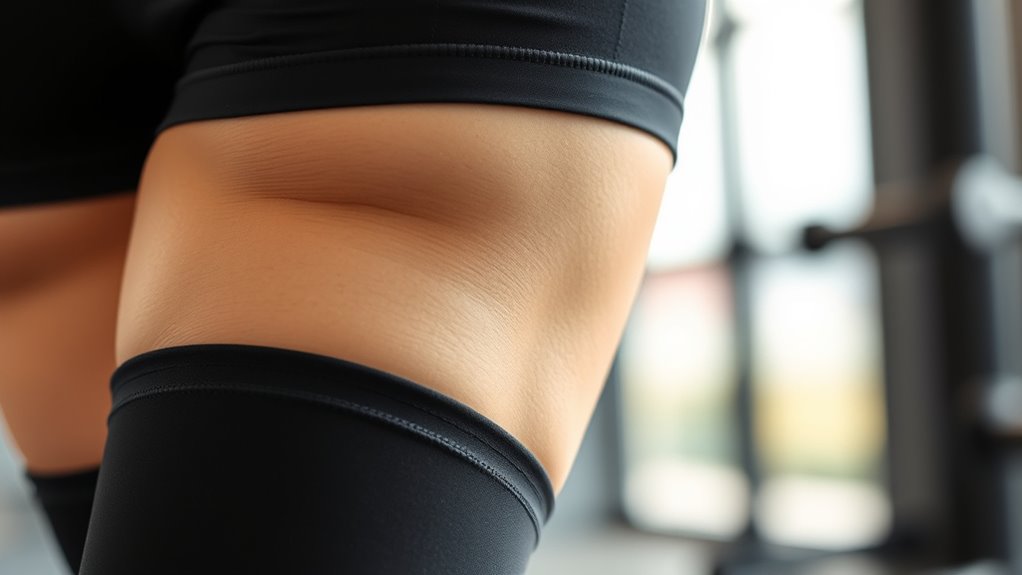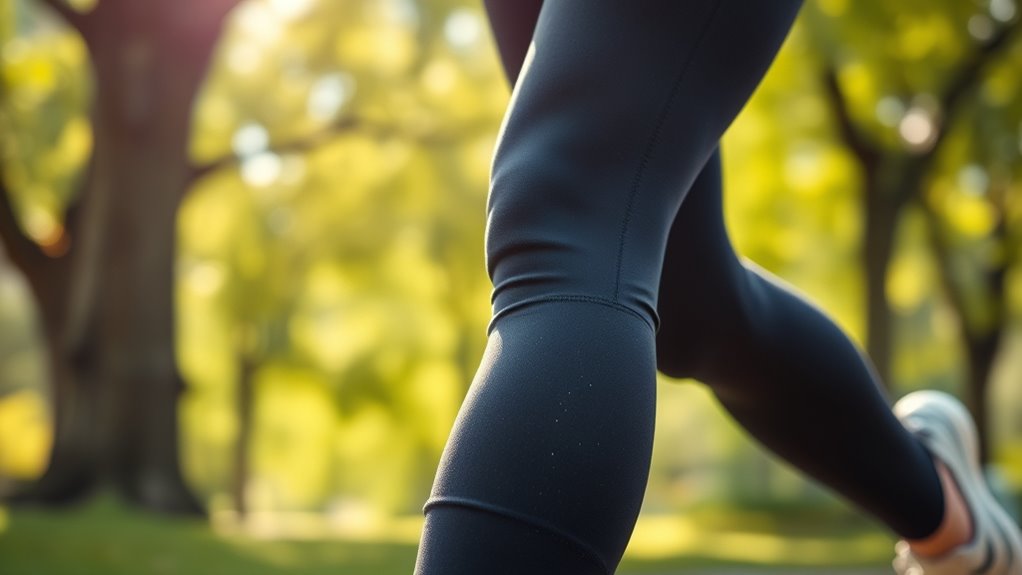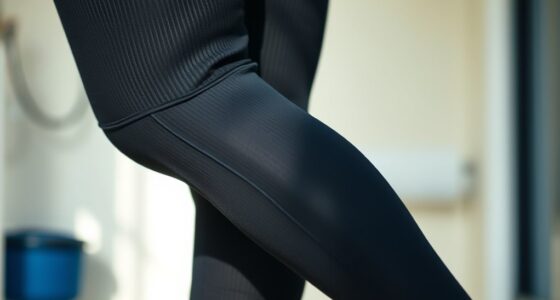Compression tights can help reduce micro-trauma by supporting your muscles, minimizing vibrations, and improving blood flow during exercise. While some studies show they may decrease muscle soreness and vibration, results are mixed, and their effectiveness depends on proper fit and compression level. They shouldn’t replace other injury prevention strategies but can be a helpful addition. To discover how to make the most of compression tights, keep exploring more insights.
Key Takeaways
- Compression tights apply gentle pressure to support muscles and reduce vibration, potentially decreasing muscle micro-trauma during activity.
- Scientific studies show mixed results, but some indicate improved circulation and reduced muscle soreness with compression gear.
- Properly fitted compression tights may help minimize micro-tears and promote quicker recovery after exercise.
- They should be used alongside other injury prevention strategies like strength training and proper warm-up routines.
- Over-reliance on compression tights alone is insufficient; comprehensive approaches are essential for effective injury prevention.
Understanding Micro-Trauma and Its Impact on Athletes

Micro-trauma refers to tiny injuries in muscles and tissues that often go unnoticed during regular training. These small tears occur when you push your muscles during exercise, leading to inflammation and soreness. Although minor, micro-trauma can hinder muscle recovery if not managed properly. Your body responds by increasing blood flow to damaged areas, which promotes circulatory improvement. Enhanced circulation delivers essential nutrients and oxygen needed for repair, speeding up healing. Over time, repeated micro-trauma without adequate recovery can cause fatigue and increase injury risk. Recognizing these tiny injuries is vital because early intervention helps reduce inflammation and supports muscle recovery. Maintaining proper circulation and recovery strategies ensures your muscles heal efficiently, keeping you active and preventing more serious injuries down the line. Additionally, using targeted recovery techniques, such as proper rest and hydration, can further aid in minimizing the effects of micro-trauma.
How Compression Tights Are Designed to Work

Compression tights are specifically designed to apply gentle, consistent pressure to your muscles, which helps improve blood flow and reduce the buildup of metabolic waste. The key to their effectiveness lies in high-quality compression fabric, which offers elasticity and durability while maintaining consistent pressure. This fabric compresses your muscles snugly without restricting movement, promoting better circulation during activity. Fit optimization is vital; tights should hug your body without feeling too tight or loose, ensuring even pressure across all areas. Proper fit enhances compression benefits and prevents discomfort or chafing. By carefully designing the fabric and fit, manufacturers aim to support your muscles, reduce vibration, and potentially decrease micro-trauma, all while allowing freedom of movement and comfort during your workout. Additionally, durable materials are essential to maintain compression levels over time, ensuring ongoing benefits with regular use.
Scientific Evidence Supporting Compression Wear for Injury Prevention

Numerous studies have investigated how compression wear can reduce the risk of sports injuries. Evidence shows mixed results, but many indicate positive compression effects, such as improved blood flow and reduced muscle oscillation. Athlete perceptions often report feeling more supported and confident when wearing compression tights, which can enhance performance and possibly reduce injury risk. The table below summarizes key findings:
| Study Focus | Key Results | Athlete Perceptions |
|---|---|---|
| Blood circulation | Increased circulation during activity | Feeling less fatigued |
| Muscle oscillation reduction | Significant decrease in muscle vibrations | Greater sense of stability |
| Injury prevention | Reduced muscle soreness post-exercise | Perceived decreased injury risk |
| Performance enhancement | Minor improvements in endurance | Increased confidence and comfort |
While evidence is promising, individual responses vary, and more research is needed to confirm definitive injury prevention benefits. Additionally, compression garment design can influence the effectiveness of these outcomes.
Limitations and Challenges of Compression Tights in Reducing Micro-Trauma

While some studies highlight the benefits of compression tights in enhancing circulation and reducing muscle oscillation, they also reveal notable limitations in addressing micro-trauma. One challenge is fabric breathability; tight-fitting materials can trap heat and moisture, potentially causing discomfort during longer wear. This may discourage consistent use, limiting their protective effects. Additionally, the cost effectiveness of compression tights can be a concern. High-quality options often come with a higher price tag, making regular use less accessible for some individuals. Moreover, the degree of compression varies among products, and not all tights provide sufficient pressure to impact micro-trauma meaningfully. These limitations suggest that while compression tights have benefits, they should be part of a broader injury prevention strategy rather than relied on solely to reduce micro-trauma. Considering product variability and user comfort can help optimize their effectiveness.
Comparing Compression Tights to Other Injury Prevention Strategies

When evaluating injury prevention strategies, it’s important to compare the effectiveness of compression tights with other approaches like strength training, proper warm-up routines, and adequate rest. While compression tights may offer benefits like improved circulation and muscle support, their role isn’t standalone. Strength training strengthens muscles and reduces injury risk more directly. Proper warm-ups prepare your body for activity, and rest allows recovery. Additionally, compression aesthetics and fashion trends influence your choice, making compression tights appealing beyond their functional benefits. However, relying solely on them overlooks exhaustive injury prevention. Combining strategies—like targeted exercises, good habits, and supportive gear—provides a more effective approach. Ultimately, understanding how compression tights stack up against other methods helps you make informed decisions tailored to your needs. Incorporating interior decor elements can also create a more motivating environment for injury prevention routines.
Practical Tips for Choosing and Using Compression Tights Effectively

Choosing the right compression tights starts with understanding your specific needs and activity level. To guarantee effectiveness, prioritize a snug compression fit that supports muscles without restricting movement. Pay attention to fabric breathability, as breathable materials keep you comfortable and help prevent overheating during intense workouts. Incorporating innovative materials can further enhance performance and comfort during exercise.
Future Directions in Compression Technology and Injury Prevention

Advances in material science are paving the way for more effective compression tights that better adapt to your body. Personalized compression strategies are becoming more feasible, allowing you to optimize injury prevention based on individual needs. These innovations promise to enhance your performance and reduce injury risks even further. Additionally, emerging trends in special events and themed breakfasts demonstrate how tailored experiences can similarly boost engagement and satisfaction.
Advanced Material Innovations
Emerging innovations in material science are driving the future of compression tights, offering enhanced injury prevention capabilities. New compression materials are lighter, more durable, and more breathable, improving overall athlete comfort. These advancements allow for better regulation of compression levels, providing targeted support without sacrificing flexibility. Researchers are exploring smart fibers that adapt to your body’s movements, optimizing compression during activity. Additionally, sustainable and eco-friendly materials are gaining popularity, aligning performance with environmental responsibility. These innovations aim to reduce micro-trauma and fatigue, helping you recover faster and perform better. The integration of yoga-inspired stretching techniques into compression gear design may further enhance flexibility and recovery.
Personalized Compression Strategies
Innovations in material science are paving the way for personalized compression strategies that can revolutionize injury prevention. With custom fit options, you can now select tights tailored exactly to your body’s contours, ensuring ideal pressure distribution and comfort. These personalized designs help reduce micro-trauma by supporting your muscles more effectively, minimizing fatigue and injury risk. Additionally, advancements in fabric breathability allow for better moisture management, keeping your skin dry and comfortable during intense activity. This integration of custom fit and breathable materials creates a more effective and comfortable compression experience. As technology evolves, personalized compression strategies will become more accessible, helping you optimize performance and recovery while lowering injury chances through tailored support.
Frequently Asked Questions
Can Compression Tights Improve Athletic Performance Besides Injury Prevention?
You might wonder if compression tights boost your athletic performance beyond injury prevention. They can improve muscle recovery and blood circulation, helping you train harder and recover faster. By supporting your muscles, compression tights reduce fatigue and soreness, allowing you to perform better over time. So, yes — wearing compression tights could enhance your overall athletic performance by promoting quicker recovery and better circulation during and after workouts.
Are Compression Tights Suitable for All Sports and Activity Levels?
You might think compression tights suit everyone, but that’s not always true. Their material breathability and fit customization are key factors that determine suitability for different sports and activity levels. If they fit well and allow airflow, you’ll feel more comfortable and supported, whether you’re running or doing high-intensity workouts. However, for less active pursuits, they might be unnecessary or uncomfortable, so consider your specific needs before choosing them.
How Long Should Athletes Wear Compression Tights for Optimal Benefits?
For ideal benefits, you should wear compression tights for about 1 to 2 hours after your workout or during activity. The compression duration varies based on your activity level and personal comfort, but generally, maintaining the prime wear time helps improve circulation and reduce muscle soreness. Listen to your body and avoid over-wearing, as longer durations don’t necessarily mean better results.
Do Compression Tights Have Any Side Effects or Risks?
Think of compression tights as a double-edged sword. While they can enhance circulation, they might also cause skin irritation or worsen circulatory issues if too tight or worn improperly. If you notice discomfort, itching, or numbness, it’s a sign to remove them. Always choose the right fit and listen to your body. Like any gear, they aren’t risk-free, but with proper use, you can enjoy their benefits safely.
What Are the Cost Considerations When Choosing Compression Tights?
When choosing compression tights, you should consider the cost analysis and affordability factors. Prices vary based on brand, material quality, and compression level, so you can find options that fit your budget. Investing in higher-quality tights might be more durable, saving you money long-term. However, balance cost with comfort and effectiveness to make sure you get the best value for your money, making your purchase both practical and beneficial.
Conclusion
While compression tights show promise in reducing micro-trauma, the full story isn’t clear yet. Will they become your ultimate injury shield, or are there limits you haven’t uncovered? As research advances and technology evolves, you may find yourself on the cusp of a game-changing breakthrough. Stay tuned—what’s next could redefine how you prevent injuries and push your limits. The future of injury prevention is just around the corner. Are you ready to embrace it?









